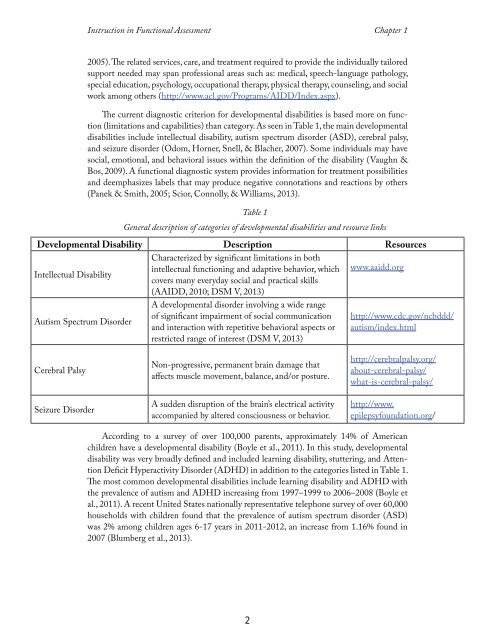Instruction in Functional Assessment, 2014a
Instruction in Functional Assessment, 2014a
Instruction in Functional Assessment, 2014a
You also want an ePaper? Increase the reach of your titles
YUMPU automatically turns print PDFs into web optimized ePapers that Google loves.
<strong>Instruction</strong> <strong>in</strong> <strong>Functional</strong> <strong>Assessment</strong> Chapter 1<br />
2005). The related services, care, and treatment required to provide the <strong>in</strong>dividually tailored<br />
support needed may span professional areas such as: medical, speech-language pathology,<br />
special education, psychology, occupational therapy, physical therapy, counsel<strong>in</strong>g, and social<br />
work among others (http://www.acl.gov/Programs/AIDD/Index.aspx).<br />
The current diagnostic criterion for developmental disabilities is based more on function<br />
(limitations and capabilities) than category. As seen <strong>in</strong> Table 1, the ma<strong>in</strong> developmental<br />
disabilities <strong>in</strong>clude <strong>in</strong>tellectual disability, autism spectrum disorder (ASD), cerebral palsy,<br />
and seizure disorder (Odom, Horner, Snell, & Blacher, 2007). Some <strong>in</strong>dividuals may have<br />
social, emotional, and behavioral issues with<strong>in</strong> the def<strong>in</strong>ition of the disability (Vaughn &<br />
Bos, 2009). A functional diagnostic system provides <strong>in</strong>formation for treatment possibilities<br />
and deemphasizes labels that may produce negative connotations and reactions by others<br />
(Panek & Smith, 2005; Scior, Connolly, & Williams, 2013).<br />
Table 1<br />
General description of categories of developmental disabilities and resource l<strong>in</strong>ks<br />
Developmental Disability Description Resources<br />
Characterized by significant limitations <strong>in</strong> both<br />
Intellectual Disability<br />
<strong>in</strong>tellectual function<strong>in</strong>g and adaptive behavior, which www.aaidd.org<br />
covers many everyday social and practical skills<br />
(AAIDD, 2010; DSM V, 2013)<br />
Autism Spectrum Disorder<br />
A developmental disorder <strong>in</strong>volv<strong>in</strong>g a wide range<br />
of significant impairment of social communication<br />
and <strong>in</strong>teraction with repetitive behavioral aspects or<br />
restricted range of <strong>in</strong>terest (DSM V, 2013)<br />
http://www.cdc.gov/ncbddd/<br />
autism/<strong>in</strong>dex.html<br />
Cerebral Palsy<br />
Non-progressive, permanent bra<strong>in</strong> damage that<br />
affects muscle movement, balance, and/or posture.<br />
http://cerebralpalsy.org/<br />
about-cerebral-palsy/<br />
what-is-cerebral-palsy/<br />
Seizure Disorder<br />
A sudden disruption of the bra<strong>in</strong>’s electrical activity<br />
accompanied by altered consciousness or behavior.<br />
http://www.<br />
epilepsyfoundation.org/<br />
Accord<strong>in</strong>g to a survey of over 100,000 parents, approximately 14% of American<br />
children have a developmental disability (Boyle et al., 2011). In this study, developmental<br />
disability was very broadly def<strong>in</strong>ed and <strong>in</strong>cluded learn<strong>in</strong>g disability, stutter<strong>in</strong>g, and Attention<br />
Deficit Hyperactivity Disorder (ADHD) <strong>in</strong> addition to the categories listed <strong>in</strong> Table 1.<br />
The most common developmental disabilities <strong>in</strong>clude learn<strong>in</strong>g disability and ADHD with<br />
the prevalence of autism and ADHD <strong>in</strong>creas<strong>in</strong>g from 1997–1999 to 2006–2008 (Boyle et<br />
al., 2011). A recent United States nationally representative telephone survey of over 60,000<br />
households with children found that the prevalence of autism spectrum disorder (ASD)<br />
was 2% among children ages 6-17 years <strong>in</strong> 2011-2012, an <strong>in</strong>crease from 1.16% found <strong>in</strong><br />
2007 (Blumberg et al., 2013).<br />
2


















